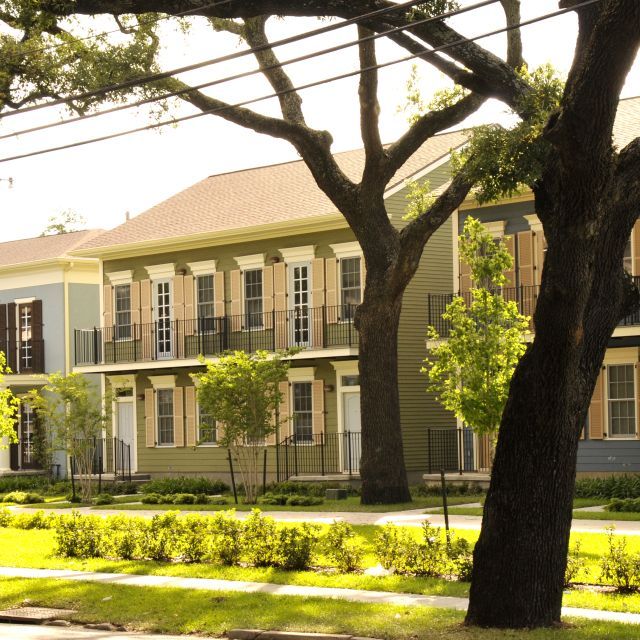In the wake of a natural disaster, low-income and other systemically marginalized residents often struggle to fully recover and access tools to build resilience against future catastrophes. Affected communities can include seniors, renters, people with limited English proficiency, people with disabilities, residents of manufactured housing, and people experiencing homelessness.
Many state and local governments have sought to address the needs of these communities using Community Development Block Grant – Disaster Recovery (CDBG-DR) funding from the U.S. Department of Housing and Urban Development (HUD). The customized and innovative approaches that grantees have developed – as well as the challenges they encountered along the way – can help communities that similarly want to prioritize equity in their post-disaster strategies.
Supporting equitable recovery is the focus of a new research report and set of guides developed by Enterprise as part of both a cooperative agreement and a technical assistance grant awarded by HUD. The research report, “Evaluating Equity Efforts and Outcomes of CDBG-DR Funded Flood Resilience in Four Communities,” summarizes a study conducted by Enterprise and Amplify for Change (Amplify) that looked at the experiences and outcomes of four CDBG-DR grantees – in Pennsylvania; New Jersey; Chicago, Illinois; and Nashville/Davidson County, Tennessee – as they worked to recover from flood-based disasters that occurred between 2010-2013. Using interviews, document reviews, and quantitative analyses, the study identifies five themes that characterize these grantees’ experiences using CDBG-DR funding for long-term recovery, especially among systemically marginalized communities:
- Local outreach and collaboration: Grantees relied on partnerships with local leaders, multiple outreach approaches, and deep community engagement to facilitate information sharing with hard-to-reach populations.
- Serving low-income and systemically marginalized communities: Delays in the allocation of CDBG-DR funding, as well as challenges navigating requirements and restrictions, limited the effectiveness of these funds for some residents, particularly renters, seniors, and other residents subject to predatory practices.
- Types of recovery/resilience activities: Common rebuilding strategies – such as elevating at-risk homes, funding flood-proofing and other resilience measures, and supporting community-wide infrastructure projects – are not always practical for all residents, so grantees may need to consider adjustments or alternatives to these to serve systemically marginalized communities in a more equitable way.
- Administrative/funding concerns: Understanding different recovery agency regulations, gathering reliable data on residents’ needs, and combining CDBG-DR funding with other resources often helped facilitate more equitable outcomes.
- Number/type of households served: Despite the efforts of grantees to achieve more equitable outcomes, disproportionately fewer low-income households, renters, and households of color benefitted from CDBG-DR funds relative to their needs and shares of the impacted populations.
The research report ends with a set of policy recommendations, including: improving communication from HUD to grantees about CDBG-DR and how it fits within the constellation of federal recovery resources; improving coordination among recovery agencies and streamlined application processes; removing some of the administrative burdens on both grantees and residents; using alternative metrics to track equity in how CDBG-DR funding is allocated and used; and permanently authorizing CDBG-DR and standardizing regulations to better support disaster recovery and resilience.
Using findings from the research report, Enterprise and Amplify developed a set of 11 standalone guides to share best practices for engendering equitable resilience in the post-disaster recovery process. The “Key Strategies and Resources for Equitable Resilience” collection is designed to help current and future CDBG-DR grantees proactively incorporate equitable practices into their recovery process and improve access to resources necessary for rebuilding and thriving after a disaster for systematically marginalized populations. The guides are organized by three themes:
- Communicating Early and Often: Guides cover how different agencies interact within the national disaster response and recovery framework, what grantees can do to set expectations with residents about when and how recovery resources will arrive, what technological tools can help reach marginalized populations, and how to track and update residents on progress with allocating recovery funds.
- Identifying and Assisting Key Populations: Guides discuss the unique challenges grantees may face when supporting specific sub-populations – including low- and moderate-income households, renters, seniors, and residents with limited English proficiency – and some solutions for overcoming these barriers.
- Reaching Impacted Residents: Guides share strategies for staying connected to residents, such as working with trusted community partners and setting up one-stop-shop resilience hubs for information and resources, as well as for anticipating and adjusting to changes in needs over time.
Throughout, the research report and guides emphasize the importance of fostering a collaborative approach to mitigating the impacts of disasters for low-income and other systemically marginalized communities. Community-based solutions that empower residents and incorporate their perspectives in decision-making processes are essential for ensuring equitable outcomes for all residents. Future grantees and policymakers should take advantage of these resources to better prioritize equity in disaster recovery.



